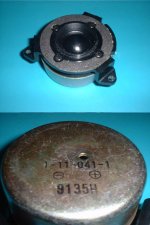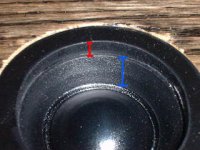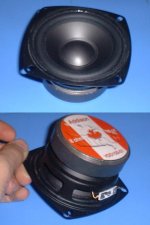Im working on this high pass second order butterworth filter for this tweeter (is it the best one for tweeters?)
ive heard that theres a 180 degree dephasation, is that true?
ive heard that theres a 180 degree dephasation, is that true?
Ilianh said:Im working on this high pass second order butterworth filter for this tweeter (is it the best one for tweeters?)
ive heard that theres a 180 degree dephasation, is that true?
What tweeter? Which XO is best for a T depends on the unit, where you are crossing it, what you are crossing it to, and the box it is mounted in.
Generally with a 2nd order filter the phase polarity of the T is flipped wrt the midbass it XOs to.
dave
Ilianh said:its a 1" dome silk tweeter, not sure of the brand... heres a pic
in a small vented satelite box, im cutting it at 4000hz
Well it was made in 1991. Other than that i've never seen the like. Looks shielded and the mounting is cool. How big is the front lip (ie how much meat is left after you route out the mounting hole?)
Without more into, some measurements (at least an impedance plot), or someone recognizing it, you are left in the realm of cut & try.
dave
ok well
the front lip is around 9 mm tall (blue line on pic). On the enclosure i made a bigger round hole for the tweeter, and added a black plastic ring thats on the same level as the wood (its exactly same thickness as the wood) because it fits with the main design, but theres a 3.5 mm difference between the ring and the tweeter's lip (red line).
How do you think that this will affect the sound?
I was wondering, how do you know it was made in 1991? The 9135h may just be a code.
I guess could make a impedance plot by measuring voltage and current at different frequensies, right? Then how would i go for making the XO, taking in account this impedance plot?
heres the pic
the front lip is around 9 mm tall (blue line on pic). On the enclosure i made a bigger round hole for the tweeter, and added a black plastic ring thats on the same level as the wood (its exactly same thickness as the wood) because it fits with the main design, but theres a 3.5 mm difference between the ring and the tweeter's lip (red line).
How do you think that this will affect the sound?
I was wondering, how do you know it was made in 1991? The 9135h may just be a code.
I guess could make a impedance plot by measuring voltage and current at different frequensies, right? Then how would i go for making the XO, taking in account this impedance plot?
heres the pic
Ilianh said:the front lip is around 9 mm tall (blue line on pic). On the enclosure i made a bigger round hole for the tweeter, and added a black plastic ring thats on the same level as the wood (its exactly same thickness as the wood) because it fits with the main design, but theres a 3.5 mm difference between the ring and the tweeter's lip (red line).
How do you think that this will affect the sound?
Is the tweeter behind or in front of the baffle. You would like the lip to be flush with the baffle.
I was wondering, how do you know it was made in 1991? The 9135h may just be a code.
I'm pretty sure it is a date code. 35th week of 1991.
I guess could make a impedance plot by measuring voltage and current at different frequensies, right? Then how would i go for making the XO, taking in account this impedance plot?
I don't really do much with passive XOs, but there are some guys here -- Kelticwizard? You listening.
dave
yup me thinks dave is right 35th week of 1991 commonly used parlance.
can you get teh Fs. atleast this will give you a good idea of the min XO freq.
given the design dont expect great dispersion chaarteristics but a narrow dispersion might be what you are after (esp if youare intending to use multiples).
use a oscillospoe to do the impednace plot as you suggested i find it easier. that will give you Fs (peak impedance around 500-2k) too.
can you get teh Fs. atleast this will give you a good idea of the min XO freq.
given the design dont expect great dispersion chaarteristics but a narrow dispersion might be what you are after (esp if youare intending to use multiples).
use a oscillospoe to do the impednace plot as you suggested i find it easier. that will give you Fs (peak impedance around 500-2k) too.
planet10 said:
Is the tweeter behind or in front of the baffle. You would like the lip to be flush with the baffle.
its mounted infront of the baffle, but the lip is 3.5 mm deep in the wood.
i`ll send more pics once i get home...
(in c++ class now... )

AS SUGGESTED.
Hi Ilianh,
As Dave suggested already,the lip ought to be flush with the wood.
Nor countersunk.
Ciao,🙂
Hi Ilianh,
its mounted infront of the baffle, but the lip is 3.5 mm deep in the wood.
As Dave suggested already,the lip ought to be flush with the wood.
Nor countersunk.
Ciao,🙂
yhea...
but i'll have a really hard time making that happen .. any ideas how the sound will be affected if i leave it as it is?
.. any ideas how the sound will be affected if i leave it as it is?
but i'll have a really hard time making that happen
 .. any ideas how the sound will be affected if i leave it as it is?
.. any ideas how the sound will be affected if i leave it as it is?THE UNKNOWN SOLDIER.
Hi,
I could be wrong but from looking at the picture there isn't much you can do about it.
Negative effects would be phase delay,diffraction, but if it is made that way and since there no frequency plot of it, these are just generalizations.
Cheers,😉
Hi,
I could be wrong but from looking at the picture there isn't much you can do about it.
Negative effects would be phase delay,diffraction, but if it is made that way and since there no frequency plot of it, these are just generalizations.
Cheers,😉
I'll post a litttle more on this later, but I would say that a 1" dome tweeter would be relatively safe to assume that you can cross over at 4K. There don't seem to be many that won't go that low.
That inset the dome is located in often means an exceptionally sensitive tweeter-don't be too surprised if this thing is 96 dB @ 1M/1W or more.
Without any frequency response charts it's just a shot in the dark, but I suppose we could try a couple of Rules Of Thumb that might do more good than harm. Possibly.
If nothing else, do you have a simple meter? See if you can measure the voice coil resistance-disconnected from any amps, of course. You know it's an 8 ohm tweeter if the DC resisitance is 5 ohms or above.
If you can remove a tweeter from a speaker you know to be about 88 dB or 90 dB, put it next to the Mystery Tweeter and run a 4K Hz tone to each one alternately , you might be able to discern if one tweeter is more sensitive than the other. There are online tone generators.
You might try a 6K Hz tone and 10K Hz tone as well. Just to get a rough idea of sensitivity level.
What mid are you planning to cross over to?
That inset the dome is located in often means an exceptionally sensitive tweeter-don't be too surprised if this thing is 96 dB @ 1M/1W or more.
Without any frequency response charts it's just a shot in the dark, but I suppose we could try a couple of Rules Of Thumb that might do more good than harm. Possibly.
If nothing else, do you have a simple meter? See if you can measure the voice coil resistance-disconnected from any amps, of course. You know it's an 8 ohm tweeter if the DC resisitance is 5 ohms or above.
If you can remove a tweeter from a speaker you know to be about 88 dB or 90 dB, put it next to the Mystery Tweeter and run a 4K Hz tone to each one alternately , you might be able to discern if one tweeter is more sensitive than the other. There are online tone generators.
You might try a 6K Hz tone and 10K Hz tone as well. Just to get a rough idea of sensitivity level.
What mid are you planning to cross over to?
yhea.. thats what i tought, crossing it at 4k hz would be on the safe side when not know its fs. Ive tried to cross it at 2500 hz for fun, and it worked fine (atleast to my ears...) but until i know more of it specs, i'd assume 4k hz
I have a multimeter, a frequency generator and a osciloscope,
Ive theile-small tested many speakers with the JBL speaker shop pro app, but it wants to give 500 hz to the speaker and im not sure i might want to do that to this tweeter.
Never tested tweeters..
the idea of comparing it with another tweeter is good... its just that i dont have any tweeters that i have specs for...
the mid is a cambridge 4" mid , i'll post pics once i get home , im at school now...
I paid this tweeter 10$ cdn and i dont think its too bad... and i might use it in some of my projects
I have a multimeter, a frequency generator and a osciloscope,
Ive theile-small tested many speakers with the JBL speaker shop pro app, but it wants to give 500 hz to the speaker and im not sure i might want to do that to this tweeter.
Never tested tweeters..
the idea of comparing it with another tweeter is good... its just that i dont have any tweeters that i have specs for...
the mid is a cambridge 4" mid , i'll post pics once i get home , im at school now...
I paid this tweeter 10$ cdn and i dont think its too bad... and i might use it in some of my projects
Ilianh said:but i'll have a really hard time making that happen.. any ideas how the sound will be affected if i leave it as it is? [/B]
You should at least bevel the lip to make the transition to the baffle smoother and reduce the soup can resonance.
dave
Ilianh said:ok, heres the mid im using for those satelites
its made by cambridge canada, imported by addison.
Not to be a wiseguy, but I have to ask:
If you live in Canada, and the mids are made by Cambridge of Canada, how do they get imported by Addison?
LOL, how do you import something that is made in the same country you're in? 🙂 🙂 🙂
OK, I gotcha now.
I am not so much interested in the Qts and such of the mid. I assume you know what you plan to do there.
I will post tomorrow on some thoughts of a crossover. Let me just say that for purposes of having a 12 dB crossover, both sides, it is a good thing for you to be using a 4" mid.
I am not so much interested in the Qts and such of the mid. I assume you know what you plan to do there.
I will post tomorrow on some thoughts of a crossover. Let me just say that for purposes of having a 12 dB crossover, both sides, it is a good thing for you to be using a 4" mid.
- Status
- Not open for further replies.
- Home
- Loudspeakers
- Multi-Way
- second order lc filters


